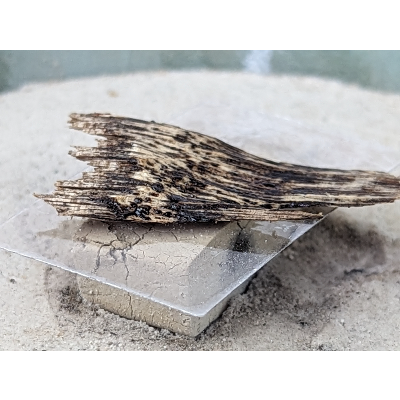Menu
-
-
F.A.Q
- How to identify genuine agarwood chip, natural or cultivated
- How to identify oil injection / absorption fake agarwood beads
- How to know if there are more than one oil in your oil
- How to make your wood bracelet or mala darker
- How to tell if an Agarwood bead sinks WITHOUT sinking it under water?
- How does back flow incense work and how do you burn it?
- Where to start if you don't know what agarwood is ?
- Why are you losing money if you buy seeds and plants?
- Which agarwood incense should I choose?
- Frequently Asked Questions
- Agarwood Related Articles
- Shipping
-
SHOP - Agarwood
-
SHOP - Other Fragrant Wood
-
SHOP - Incense Holder and Burner
-
- FREE Oud Oil guide
- Testimonials
- "Why did you buy this?"
- Contact us
- About Us
- +61430284329
- Login
-
English


A Closer Look at Why Some People Are Repelled by the "smell" of Burning Agarwood Chips.
September 10, 2023 10 min read
Table of Contents:[hide]
Smell preferences are personal
Smell preferences vary greatly among individuals, much like taste preferences. What is pleasing to one person's olfactory receptors may be displeasing to someone else's. Several factors contribute to this phenomenon:
-
Genetics: The genes that encode for olfactory receptors are highly diverse in the human population. This genetic variation can lead to differences in the way individuals perceive certain smells. One example could be "yeast". Have you ever walked pass a beer factory? I love the yeast smell but my friend hates it. Why? Maybe my friend and I have different genes that determine how ournoses pick up on the scent of the yeast.
-
Past Experiences: Associative learning and memory can influence an individual's preference for certain smells. For example, if a person has a positive experience associated with a particular scent, they may find it more pleasing in the future.
-
Cultural Background: Cultural factors and upbringing can also shape an individual's perception of smell. What is considered a pleasant scent in one culture might not be viewed the same way in another. Different societies have different culinary traditions, exposure to specific flora and fauna, and cultural practices related to scents, all of which can influence preferences.
In Indian cuisine, spices like cumin, coriander, and turmeric are commonly used, and the aroma of these spices cooking may be considered comforting and appetizing by those who grew up in Indian households or are accustomed to Indian culinary traditions.
Contrastingly, in some Western cultures where these spices are not commonly used in everyday cooking, the same smells might be considered unusual or even off-putting. People who did not grow up with these scents might not have the same positive association, and may even find the smell to be overpowering or unpleasant.
This difference in perception underscores how cultural practices and exposure to certain scents from a young age can heavily influence what one considers to be a pleasant or unpleasant aroma. It highlights the relativity of olfactory preferences across different cultures and communities.
-
Physical Health and Age: Health conditions and age may alter the sense of smell. Certain illnesses or medications can change the way scents are perceived. As people age, their sense of smell may become less acute, leading to changes in preferences. Kids love sweet smell while elders have different palettes. That favorite scented candle that once smelled sweet and floral might not have the same effect anymore, or the aroma of a favorite dish might need some extra seasoning to taste just right.
-
Environmental Factors: The surrounding environment and the context in which a smell is experienced can also influence perception. For example, a fragrance that is associated with cleanliness might be perceived differently in a bathroom compared to a kitchen.
Why am I telling you this? Because Agarwood are all about smells and smells are personal. It means many love them while others hate. And it has nothing to do with the quality.
Myth: it smells bad, its quality must be bad
Quality and What You Like is Not the Same:
The quality of something has to do with how pure it is, if it is real, and if it is made well. Whether or not you like something is about your own personal likes and dislikes. I have some stories that I would like to share with you.
Lavender: A Calming Herb or a Remedy Gone Wrong?
My friend found the scent calming and relaxing, reminiscent of her grandmother's gardens, where she used to play as a child. Another friend, however, was reminded of a strong medicinal ointment she had to use once when she was sick. To her, the smell was unappealing and too sharp.
Vanilla: Sweet Treat or Overwhelmingly Sugary?
Many people find vanilla comforting, sweet, and it brings back memories of baking cookies with their mothers during Christmas. While other people, on the other hand, found it cloyingly sweet and overpowering, associating it with a synthetic air freshener in a taxi she once rode in.
This is similar to lemon, which reminds people of dishwashing liquid. The lemon smells great, but to some people, it does not smell like lemon anymore, it does not remind them of the juicy refreshing taste but a household chore that they have been doing.
Cedarwood: Earthy Connection or Hamster Cage Reminder?
I love it instantly. Cedarwood smells great with its earthy, woody scent that reminded her of hiking trips with friends. But if someone may not like it because it reminds her childhood pet hamster's wood-shaving bedding.
Why am I sharing these stories with you?
Something like genuine Agarwood can be very good quality, but not everyone will like how it smells, especially when this is the first time he or she tries it.
Different Backgrounds and Cultures: Some smells might be unfamiliar to people from different places or backgrounds.
What You Expect vs. What You Get:
Sometimes, people expect something to smell a certain way because of what they have heard or read. If the real smell is different from what they expected, they might be surprised, even if the product is really good.
If you have been burning Bakhoor and have not used Agarwood before, you may expect Agarwood smells like Bakhoor or even stronger than Bakhoor. Many sellers said Bakhoor is oud or contains Oud. While it could be true, you need to know the main difference between Agarwood and Bakhoor:
- Agarwood: It is a rare and precious wood that comes from the Aquilaria tree, known for its distinct fragrance. Burning Agarwood chips will give you a subtle, complex, woody fragrance. You need to pay attention to the smell to learn about it. The fragrance is not as strong as oil-scented products.
- Bakhoor: It is a blend of scented chips or bricks made from a combination of various raw materials like wood chips, resins, ambergris, musk, and essential oils. Bakhoor is often associated with aromatic fumigation in the Middle East and is used on special occasions or for perfuming the house. Bakhoor may contain Agarwood chips but often contains used or spent Agarwood chips (with little to no resin left).
Bakhoor and Scented Oil:
- Because Bakhoor is made using scented oils and other fragrant substances, its aroma can indeed be much stronger and more pronounced than the natural, subtle scent of pure Agarwood. The blending of various ingredients in Bakhoor can create a potent and rich olfactory experience. The aroma will be stronger the burning Agarwood chips
While each of us has our own preference of smell. So when someone says the aroma of burning Bakhoor is better than Agarwood chips, there is no right or wrong answer here. It is just a personal preference.
Stronger Does Not Mean Better or Worse:
- A stronger scent doesn't inherently mean it's better or worse. Some people might prefer the robust, multifaceted aroma of Bakhoor, while others might lean towards the subtle, natural notes of Agarwood. Again, it boils down to personal preference. Just as with beer or any other sensory experience, what one person finds appealing, another might not, and vice versa, a “weaker” more subtle scent does not mean the chips are bad.
How Our Brains Work:
Our brains all process smells in their own way. The parts of the brain that handle feelings and memories are connected to the part that processes smells. This means that how we feel about a smell can be influenced by our feelings and memories.
It Takes Time to Like Some Smells: Just like it takes time for some people to start liking things like coffee or wine, the same can happen with smells like Agarwood. If someone does not like it at first, that does not mean it is bad; it might just be something they are not used to.
So you tried our woodchips, and you don’t like the smell. Thinking of a refund?
I get it. It is frustrating when you expect onething and get another thing.
But first, please understand this: Liking a smell and the quality of the product are two different things.
Ever heard of Durian Fruit? Ask someone who loves Durians and listens to what they say.
Then ask someone who immediately feel anxious when they hear about the word "Durian"
That is why in Singapore they ban Durian in some public place.
But you see, it does not mean Durian has a bad smell :)
Imagine you bought a Durian home, and the next day bring it back to the vendor and ask for a refund.

Photo by AS Flickr
If the product is faulty, for example, fake wood, by law, I will refund it to you, no question asked.
However, to prove my wood is fake, you may need to spend $300++ for a lab to conclude, which is not viable.
So, the easiest way is to email me, and we will work something out together.
If you do not like the smell of our chips, the same smell that many people like, because you feel it is absolutely “plain”, “no smell” , or “shocked”, let me know so I can understand what could go wrong.
You see, selling low-quality chips is the last thing I want to do. So it will never be my intention to “scam” you.
Here is an unofficial review during a chat with me from of my customer, please note there is no incentive for her/him to write this

Here is another review, again no incentive is given whatsoever.

Anyway
The aroma is not right or not what you expect, it is usally the temperature is not right.
The importance of temperature control when burning fragrant wood is crucial in achieving the desired aromatic effect.
-
Naked Flame Contact with the Wood: if the naked flame directly contacts the wood, it may lead to over-burning, resulting in a burnt and bitter smell. The flame's direct contact with the wood can cause it to burn too quickly and intensely, destroying the delicate fragrance compounds. See the below image, you will experience a short sweet woody at first but quickly when the wood turn into ash, you will feel burn bitter notes.

-
Too Hot: When the temperature is too high, the fragrant wood tends to lose its characteristic scent, and it may smell like burnt wood. The excessive heat can cause the delicate compounds within the wood that are responsible for its aroma to break down. Instead of releasing the intended fragrance, it will produce an unpleasant burnt odor.
-
Not Enough Heat: On the other hand, if the temperature is too low, the wood may not burn properly, leading to little or no release of its fragrance. The heat must be sufficient to trigger the release of the volatile oils and compounds that create the scent. Low temperatures will not allow these compounds to vaporize, and the desired smell will not be achieved.
-
Using an Oil Burner with Wood Chips: If someone decides to use an oil burner to heat wood chips, the distance between the naked flame and the wood plays a significant role in the process. If the distance is too far, the heat may not reach the wood effectively, resulting in no smell. It is necessary to find the optimal distance where the heat can sufficiently reach the wood to release its aroma without burning it.
Finding the right balance in temperature and understanding the relationship between the heat source and the fragrant wood is vital to enjoying the unique scents that different types of fragrant wood can provide. Careful consideration of the distance between the flame and the wood, as well as the intensity of the heat, can lead to a pleasant and soothing aromatic experience.
Now that we have delved into the intricacies of personal preferences regarding scents, particularly Agarwood, we can take a step closer to the actual experience of this unique aroma. Understanding that quality and personal preference are distinct allows us to approach Agarwood with an open mind. If you find yourself intrigued by this storied and culturally rich fragrance, you may be ready to try it for yourself. Whether you are a seasoned enthusiast or a newcomer eager to explore, the following section provides a practical guide to embracing Agarwood's soothing scent right in your home.
Let's dive into the age-old tradition of enjoying Agarwood chips, where you can create an enchanting ambience that transcends the ordinary.
How to Enjoy Agarwood Chips: A Traditional Experience at Home
Agarwood, a fragrant heartwood used in perfumes and incense, has long been treasured in many cultures. It has an especially significant role in traditional Japanese ceremonies, often used to welcome guests with its rich and calming aroma. For those looking to incorporate this beautiful scent into their homes, here's a guide on how to enjoy agarwood chips to the fullest.
What You'll Need:
- Agarwood chips
- White ash
- Charcoal pieces for agarwood
- A vessel, ideally the size of a sake cup or slightly shallower
- Tiny chopsticks or tongs
- A lighter (preferably a piezoelectric lighter for a better experience)
Steps to Enjoy Agarwood:
-
Prepare the Vessel: Ensure your chosen vessel is clean and dry. This will hold the white ash and charcoal, acting as the foundation for the agarwood chips.
-
Light the Charcoal: Using your lighter, ignite a piece of charcoal, ensuring that about one-third of it is well-lit. For those aiming for a clearer ambiance, lighting just the inkstick is recommended. Once the charcoal has turned red and is emitting heat, it's ready for the next step.
-
Place the Charcoal on Ash: In your vessel, place a layer of white ash, then set the lit charcoal on top, burying about half or one-third of it in the ash. Wait until the ash is formed around the charcoal for best result

-
Break the Agarwood into smaller pieces: Instead of placing a whole chip of agarwood on the charcoal, break it into smaller pieces. If you're having difficulty, using scissors can be a handy method. Aim for a piece roughly the size of a thumb's tip.
From this

To this

- Place a Mica plate on the charcoal: This to further reduce the temperature
-
Place the Agarwood on the Mica Plate (the mica plate is on top of the burning charcoal):

Gently set the agarwood piece on the ash-covered charcoal. The heat from the charcoal will activate the agarwood, releasing its unique fragrance. The scent will be smokeless and gentle, filling the room with its calming aroma. -
Enjoy the Aroma: The activated charcoal will last for about 30-40 minutes, during which the aroma from the agarwood will be most potent. However, the lingering scent can be enjoyed for over an hour. The heat from the charcoal allows the aroma to permeate the room, creating a relaxing environment.
Safety Tips:
-
Since the charcoal becomes quite hot, always place your vessel on a heat-resistant surface, like a coaster or plate, to avoid any damage.
-
Be cautious when handling lit charcoal and always ensure it's fully extinguished after use.
Agarwood has a long-standing history in traditional ceremonies, especially in tea ceremonies in Japan. Its gentle and soothing scent has a way of welcoming guests and creating an atmosphere of tranquility. By following the steps mentioned above, you can bring this traditional experience right into your home, making any ordinary day feel a bit more special.
Leave a comment
Comments will be approved before showing up.
Also in News

What is Tasbih? The Deep Meaning of Subhan Allah and the Role of Prayer Beads
November 09, 2025 4 min read
